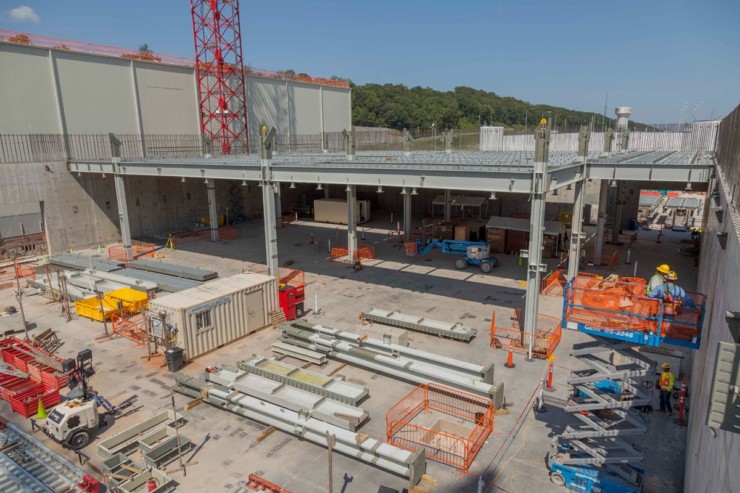
A federal judge in Knoxville on Tuesday said a critical decision made in 2016 for enriched uranium operations at the Y-12 National Security Complex, including for the $6.5 billion Uranium Processing Facility, violated a national environmental law, and she ordered the decision vacated, or set aside.
The UPF is already under construction, and Wedenesday morning, the National Nuclear Security Administration, which oversees work at Y-12, said construction will continue.
The 104-page opinion and order was filed in U.S. District Court on Tuesday by Chief U.S. District Judge Pamela L. Reeves.
The lawsuit was initially filed in U.S. District Court in the District of Columbia, but it was later moved to the Eastern District of Tennessee. Besides OREPA, the plaintiffs included two other public interest organizations—Nuclear Watch of New Mexico and Natural Resources Defense Council of Washington, D.C.— and several individual plaintiffs.
One of the plaintiffs said the decision to vacate the amended record of decision published in the Federal Register in 2016 means the NNSA no longer has the legal authority to continue construction work at UPF.
But the NNSA said it was pleased that the court’s memorandum opinion rejected almost all of the plaintiff’s claims regarding National Environmental Policy Act violations related to UPF construction.
“However, with the court agreeing that there was inadequate consideration of new information concerning seismic hazards at Y-12, NNSA will review the seismic analysis while conferring with the Department of Justice on the possibility of appeal,” the NNSA said. “In the meantime, construction of UPF will proceed.”
Besides the amended record of decision, Reeves said supplement analyses prepared in 2016 and 2018 also violated the National Environmental Policy Act, or NEPA, and she said they were to be set aside as well.
In her ruling, Reeves ordered the NNSA to conduct more environmental studies, including one of earthquake hazards at Y-12 using updated seismic information.
The UPF is a multi-building facility described as the federal government’s largest construction project in Tennessee since World War II. It’s expected to be completed by 2025 at a cost of no more than $6.5 billion. It will consolidate enriched uranium work and replace some old buildings at Y-12, which was built to enrich uranium for atomic bombs during World War II.
After Tuesday’s decision, the next steps were not immediately clear. Ralph Hutchison, coordinator of the Oak Ridge Environmental Peace Alliance, a plaintiff in the lawsuit, said the plaintiffs will wait to see how the government responds.
The plaintiffs believe the NNSA should abide by the federal’s court ruling, and construction should stop until the NNSA has the proper environmental documents required by law, Hutchison said. He said that would include a new record of decision and other proper paperwork.
“The NNSA should do what we asked them to do several years ago: Prepare a new site-wide environmental impact statement for Y-12,” Hutchison said.
The lawsuit was filed in July 2017. It alleged that DOE and the NNSA had violated the federal environmental law, and it asked for an environmental review of the new UPF design. At one time, UPF was going to be a single building next to the Highly Enriched Uranium Materials Facility at Y-12. It would have consolidated the manufacturing operations in one building. But the 2016 record of decision reported that the UPF, which would now be smaller, would have several buildings, and the NNSA would continue to house some enriched uranium operations in existing buildings, which would be upgraded. That was part of an effort to hold down costs, and it followed a review of the project by a group known as the Red Team
Hutchison cited two old buildings that he said will continue to be used, 9215 and Beta 2E. They don’t meet seismic standards, among other things, Hutchison said.
When they filed their lawsuit in 2017, the plaintiffs warned that the NNSA did not consider, after the change in the UPF design, the increased odds of large earthquakes and the hazards they might pose to the old buildings. The plaintiffs said new earthquake data published by the U.S. Geological Survey in 2014, after a 2011 record of decision but before the 2016 record of decision, must be considered in the NNSA’s environmental analysis. On Tuesday, Reeves agreed, the plaintiffs said, although she rejected two of their other claims.
“Y-12 is located in a populous and quickly growing part of the country,” the plaintiffs said, citing Reeves’ ruling. “Within the range of possible NEPA cases that might come through this courthouse, the court is hard-pressed to imagine a more dramatic hypothetical than this, where it must contemplate what might occur if a major earthquake struck a nuclear weapons manufacturing facility located in a major population center.”
In her ruling, Reeves said the 2014 map showed a much higher earthquake hazard for all of East Tennessee than previous versions had. And structural reviews of existing buildings at Y-12 by the Defense Nuclear Facilities Safety Board revealed many structural deficiencies in buildings that were now going to remain at the 811-acre nuclear weapons plant, Reeves said.
Besides considering the new information on seismic hazards, the plaintiffs said they want the NNSA to involve the public in any ongoing decision-making process.
The lawsuit was initially filed in U.S. District Court in the District of Columbia, but it was later moved to the Eastern District of Tennessee. Besides OREPA, the plaintiffs included two other public interest organizations—Nuclear Watch of New Mexico and Natural Resources Defense Council of Washington, D.C.— and several individual plaintiffs.
The current defendants are Energy Secretary James Richard “Rick” Perry and NNSA Administrator Lisa E. Gordon-Hagerty.
Read Reeves’ opinion and order here.
More information will be added as it becomes available.
You can contact John Huotari, owner and publisher of Oak Ridge Today, at (865) 951-9692 or john.huotari@oakridgetoday.com.
